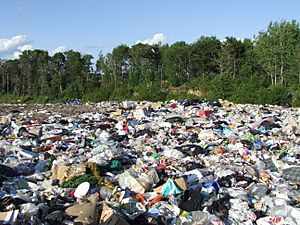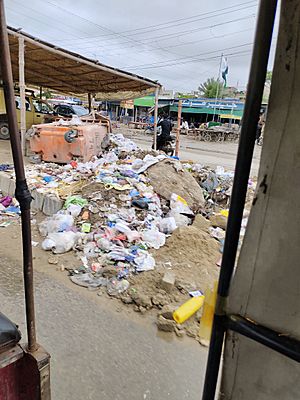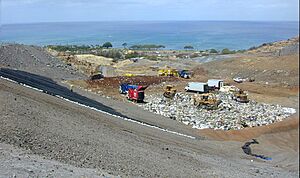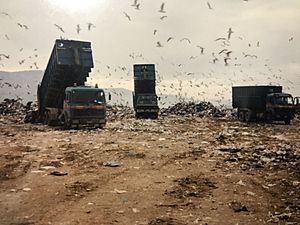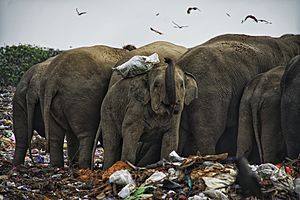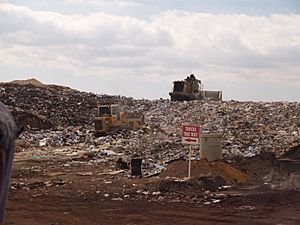Landfill facts for kids
A landfill is a special place where we put our trash and other waste materials. It's also called a dump or rubbish dump. Landfills are the oldest and most common way to get rid of waste. In the past, people just left trash in piles. But since the 1940s, we started burying waste in a more organized way. This includes covering it daily with soil.
Some landfills are used for more than just burying trash. They can be places for temporary storage or for sorting and recycling waste. Once a landfill is full, the land can be cleaned up and used for other things, like parks.
Contents
How Landfills Work
Well-managed landfills follow specific steps to handle non-hazardous waste. They aim to:
- Keep waste in the smallest area possible.
- Press the waste down to reduce its size.
They also cover the waste every day. This cover is usually a layer of soil. Sometimes, they use other materials like woodchips or special foam.
When trash trucks arrive at a landfill, they are often weighed. This helps keep track of how much waste comes in. Workers might also check the loads to make sure they only contain allowed waste. After weighing, trucks drive to the "tipping face." This is where they unload their trash. Big machines like compactors or bulldozers then spread and press the waste. This makes it take up less space. Before leaving, trucks might drive through a wheel-cleaning area.
Every day, the compacted waste is covered with soil or other materials. The space used by the waste and its daily cover is called a "daily cell." Pressing the waste down is very important. It helps the landfill last longer.
Sanitary Landfills
The term landfill usually means a sanitary landfill. These special facilities were designed to be much cleaner than old, open dumps. They became widely used in the 1960s and 1970s. A sanitary landfill is an engineered site. It is built to separate and contain waste safely.
Sanitary landfills are like big biological reactors. Tiny living things called microbes break down the complex waste. Over time, they turn it into simpler, less harmful substances. These landfills must be designed and run according to strict rules.
Waste breaks down in stages. First, it breaks down with air (aerobic decomposition). Then, it breaks down without air (anaerobic degradation). As waste breaks down, it creates gases and liquids.
Environmental Effects of Landfills
Landfills can cause several problems if not managed well. Heavy trucks can damage local roads. Dirt and pollution can spread from truck wheels onto roads and into nearby water. The environment around the landfill can also get polluted. This includes underground water sources (aquifers) and the soil.
Leachate (Polluted Liquid)
When rain falls on an open landfill, water seeps through the trash. This water picks up harmful materials. It becomes a polluted liquid called leachate. If leachate is not contained, it can pollute groundwater. Modern landfills use thick, waterproof liners and special collection systems. These systems catch the leachate. The collected leachate can then be treated or evaporated.
Once a landfill is full, it is sealed. This stops rain from getting in and making new leachate. However, even the best liners might eventually leak. So, the ground around landfills must be checked regularly. This helps prevent pollutants from reaching groundwater.
Landfill Gases
Rotting food and other organic waste create gases. The main gases are carbon dioxide (CO2) and methane (CH4). These gases are produced as waste breaks down. Methane is a powerful greenhouse gas. It traps heat in the atmosphere and contributes to climate change. Methane is also flammable and can explode if it builds up.
In well-managed landfills, these gases are collected. They can be burned off safely (flared). Or, they can be used to create electricity. Using landfill gas for energy is a clean way to produce power. This is because the carbon released from decaying plants and food waste was already part of the natural carbon cycle.
Pests
Poorly managed landfills can attract pests like rats and flies. These animals can spread diseases. Covering the waste daily helps to keep these pests away.
Other Problems
Other issues can include harm to wildlife. Animals might lose their homes or get sick from eating trash. Landfills can also cause dust, bad smells, and noise pollution. They can even lower the value of nearby properties.
Landfill Gas Collection
As mentioned, gases are produced in landfills when microbes break down waste without air. In a properly managed landfill, this gas is collected and used. It can be burned or used to generate electricity. Monitoring systems alert workers if gas levels become too high. In some countries, like the United States, many landfills have systems to collect and use this gas.
Landfill Practices Around the World
Different countries have different rules for landfills:
- Canada: Landfills are regulated by environmental agencies in each province. Older sites are checked for leaks. Some old landfills have been turned into parks.
- European Union: Countries in the EU must follow the European Landfill Directive. Many EU countries have laws that ban or severely limit putting household trash into landfills.
- India: Landfilling is the main way to get rid of city waste in India. However, there are often problems due to fast growth and poor management. Fires are common in Indian landfills.
- United Kingdom: Landfill practices in the UK have changed to meet EU rules. The UK now charges a tax on biodegradable waste sent to landfills.
- United States: Landfills in the U.S. are regulated by each state's environmental agency. These rules must meet or exceed standards set by the U.S. Environmental Protection Agency (EPA). Getting permission to build a landfill can take many years and cost millions of dollars. This is because many studies are needed to ensure safety and protect the environment.
Types of Landfills
- Municipal solid waste landfills: These take household trash and other non-hazardous materials. Some are "bioreactor landfills," which are designed to break down organic waste faster.
- Industrial waste landfills: These are for waste from businesses and factories. This can include construction and demolition debris.
- Hazardous waste landfills: These are for dangerous waste materials. They are very strictly monitored to prevent harm.
Reusing Materials from Landfills
Landfills can be seen as a source of materials and energy. In developing countries, people often search through landfills to find usable items. Some companies also explore landfills to recover materials and energy. A common example is collecting landfill gas for energy. Other facilities, like waste incinerators, can also recover materials.
Alternatives to Landfills
Besides reducing waste and recycling, there are other ways to handle trash:
- Waste-to-energy incineration: Burning waste to create energy.
- Anaerobic digestion: Using microbes to break down waste without oxygen, producing biogas.
- Composting: Turning organic waste into nutrient-rich soil.
- Mechanical biological treatment: A process that sorts and treats waste before disposal.
- Pyrolysis and plasma arc gasification: Advanced methods that use high heat to break down waste.
These methods can sometimes be more cost-effective than landfills, depending on local conditions.
Restrictions on Landfills
Some countries, like Germany, Austria, Sweden, Denmark, Belgium, the Netherlands, and Switzerland, have banned putting untreated waste into landfills. In these countries, only certain hazardous wastes or treated materials can still be buried.
See also
 In Spanish: Vertedero (basura) para niños
In Spanish: Vertedero (basura) para niños
Images for kids


